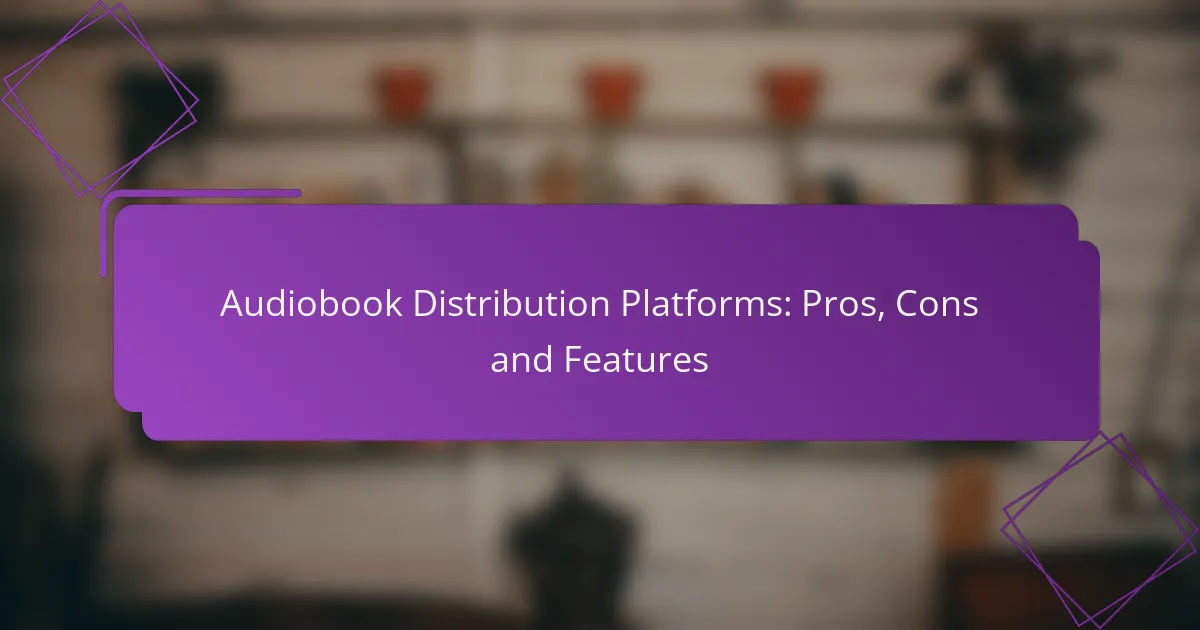Tracking audiobook sales performance requires a strategic approach that combines sales tracking software, analytics tools, and customer feedback. By focusing on key metrics such as total sales volume and revenue per title, authors and publishers can gain valuable insights into market trends and customer preferences. Understanding the diverse tracking methods across platforms is essential for optimizing marketing strategies and enhancing sales outcomes.

How to track audiobook sales performance effectively?
To track audiobook sales performance effectively, utilize a combination of sales tracking software, analytics tools, retailer reports, and customer surveys. This multifaceted approach provides a comprehensive view of sales trends, customer preferences, and overall market performance.
Utilizing sales tracking software
Sales tracking software is essential for monitoring audiobook sales across various platforms. These tools can automate the collection of sales data, providing real-time insights into performance metrics such as revenue, units sold, and market trends.
When selecting software, consider features like integration with multiple retailers, customizable dashboards, and reporting capabilities. Popular options include platforms like BookTrack and SalesBinder, which cater specifically to the publishing industry.
Implementing analytics tools
Analytics tools help you interpret sales data by providing deeper insights into customer behavior and preferences. By analyzing metrics such as conversion rates and customer demographics, you can identify which audiobooks resonate most with your audience.
Google Analytics and similar platforms can track user engagement on your website or app, allowing you to refine marketing strategies and optimize sales funnels. Regularly reviewing these analytics can lead to informed decisions that enhance sales performance.
Monitoring retailer reports
Retailer reports are crucial for understanding how your audiobooks are performing on different sales platforms. Most major retailers, like Audible and Apple Books, provide detailed sales reports that outline sales volume, revenue, and customer ratings.
Regularly check these reports to identify trends and adjust your marketing strategies accordingly. Pay attention to seasonal fluctuations and promotional impacts, as these can significantly influence sales performance.
Conducting customer surveys
Customer surveys are an effective way to gather direct feedback on your audiobooks. By asking listeners about their preferences, experiences, and suggestions, you can gain valuable insights that inform future projects and marketing efforts.
Consider using tools like SurveyMonkey or Google Forms to create and distribute surveys. Aim for concise questions that encourage honest feedback, and offer incentives such as discounts on future purchases to increase response rates.

What metrics are essential for audiobook sales analysis?
Key metrics for analyzing audiobook sales include total sales volume, revenue per title, customer acquisition cost, and return on investment. These metrics provide insights into performance, profitability, and marketing effectiveness, helping publishers and authors make informed decisions.
Total sales volume
Total sales volume refers to the number of audiobooks sold within a specific period. Tracking this metric helps gauge overall market demand and the effectiveness of marketing strategies. For example, a spike in sales volume may indicate successful promotional efforts or seasonal trends.
To effectively monitor total sales volume, consider using sales tracking software that integrates with your distribution platforms. Regularly reviewing this data allows you to adjust marketing tactics and inventory management accordingly.
Revenue per title
Revenue per title measures the average income generated from each audiobook sold. This metric is crucial for understanding which titles are performing well and which may need additional marketing support. A higher revenue per title often indicates a strong market fit or effective pricing strategy.
To calculate revenue per title, divide total revenue by the number of titles sold. Aim for a consistent review of this metric to identify trends and optimize pricing strategies, potentially adjusting based on listener feedback or competitive analysis.
Customer acquisition cost
Customer acquisition cost (CAC) is the total expense incurred to acquire a new customer, including marketing and promotional costs. Understanding CAC is vital for evaluating the efficiency of your marketing efforts. A lower CAC suggests a more effective strategy, while a higher CAC may warrant a reassessment of marketing channels.
To calculate CAC, divide total marketing expenses by the number of new customers acquired during that period. Keep an eye on this metric to ensure that your marketing investments yield a sustainable return.
Return on investment
Return on investment (ROI) measures the profitability of your audiobook sales relative to the costs incurred. A positive ROI indicates that your sales efforts are generating more revenue than expenses, which is essential for long-term sustainability. Aim for an ROI that meets or exceeds industry benchmarks.
To calculate ROI, subtract total costs from total revenue, then divide by total costs and multiply by 100 to get a percentage. Regularly assessing ROI helps you make data-driven decisions about resource allocation and marketing strategies, ensuring that you focus on the most profitable titles and campaigns.
![]()
How do different platforms compare in audiobook sales tracking?
Different platforms offer varying methods and metrics for tracking audiobook sales, impacting how authors and publishers analyze performance. Understanding these differences can help optimize marketing strategies and sales efforts.
Audible sales metrics
Audible provides detailed sales metrics, including total sales, royalties earned, and listener engagement data. This platform tracks performance through its dashboard, allowing authors to see trends over time and adjust their marketing accordingly.
Key metrics to focus on include the number of downloads, average listening time, and customer ratings. Authors should regularly review these figures to identify successful titles and areas needing improvement.
Kobo’s reporting features
Kobo offers a straightforward reporting system that highlights sales performance across different regions. Users can access sales data, including units sold and revenue generated, through their Kobo Writing Life dashboard.
It’s beneficial to analyze sales by region, as this can reveal which markets respond best to specific genres. Authors should consider leveraging promotional tools available on Kobo to boost visibility in underperforming areas.
Google Play Books analytics
Google Play Books provides analytics that focus on sales trends, customer demographics, and user engagement. This platform allows authors to track how many copies are sold and the average rating of their audiobooks.
Utilizing Google Play’s analytics can help authors understand their audience better and tailor their marketing efforts. Regularly checking these metrics can inform decisions on pricing strategies and promotional campaigns to enhance sales performance.
![]()
What are the challenges in tracking audiobook sales?
Tracking audiobook sales presents several challenges, including data accuracy, integration with existing systems, and limitations in real-time tracking. These issues can hinder effective sales analysis and decision-making for publishers and authors.
Data accuracy issues
Data accuracy is a significant challenge in tracking audiobook sales, as discrepancies can arise from multiple sources. For instance, sales data may vary between platforms due to differences in reporting methods or delays in data updates.
To mitigate these issues, it is crucial to establish a standardized reporting framework across all sales channels. Regular audits and reconciliations can help identify and correct inaccuracies, ensuring that sales figures reflect true performance.
Integration with existing systems
Integrating audiobook sales tracking with existing systems can be complex, especially for businesses using various software tools. Compatibility issues may arise when trying to connect sales data from different platforms, leading to fragmented insights.
To address this, consider using middleware solutions that facilitate data exchange between systems. Additionally, investing in comprehensive sales management software that supports audiobook sales can streamline integration and improve overall data coherence.
Real-time tracking limitations
Real-time tracking of audiobook sales is often limited by the reporting capabilities of sales platforms. Many platforms provide updates on a daily or weekly basis, which can delay insights into current sales trends.
To enhance real-time tracking, look for platforms that offer near-instantaneous reporting features. Setting up alerts for significant sales changes can also help you respond quickly to market dynamics and adjust marketing strategies accordingly.
![]()
What tools enhance audiobook sales tracking?
Effective audiobook sales tracking relies on specialized tools that provide insights into performance metrics. These tools help authors and publishers understand sales trends, customer behavior, and subscription dynamics, enabling informed decisions to boost revenue.
Book Report for sales insights
Book Report is a powerful tool that aggregates sales data from various platforms, offering clear insights into audiobook performance. It allows users to visualize sales trends over time and compare performance across different titles or formats.
Key features include customizable dashboards and detailed reports, which can help identify best-selling titles and underperformers. Users should ensure they regularly update their data sources to maintain accuracy and relevance in their sales tracking.
ChartMogul for subscription metrics
ChartMogul specializes in subscription analytics, making it ideal for audiobook services that operate on a subscription model. It tracks metrics like Monthly Recurring Revenue (MRR), customer churn, and lifetime value (LTV), providing a comprehensive view of subscription health.
To maximize its effectiveness, users should integrate ChartMogul with their payment processors and CRM systems. This integration allows for real-time data updates and more accurate forecasting, which can significantly enhance decision-making for subscription-based audiobook offerings.


